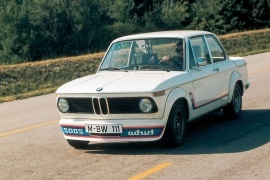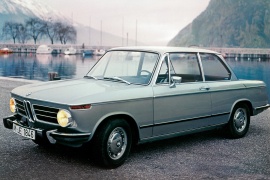BMW 2002 Models/Series Timeline, Specifications & Photos
First production year: 1968
Engines: Gasoline
Body style: Coupé (two-door)
It was the first turbocharged European car, and BMW proved that it could do a performance car out of a small-sized, two-door coupe such as the 2002.
BMW introduced the turbocharged version of the 2002 in 1973, but unfortunately, the oil crisis struck the car market that year. The German automaker made 1672 examples until late 1975 before pulling the plug. But it was enough to start all the vibe surrounding the Bavarian sports cars.
Even though it was based mainly on the 1600 model, it had some unique features, such as the plastic over-fenders mounted on both wheel arches. These helped the automaker slightly enlarge the car's track when it installed the skinny tires, even though by those time standards were quite wide. At the front, the BMW kept the regular round headlights and the black grille adorned by the brand's kidney-grille design signature. The bumper was extended downward by an apron. From its profile, the boxy-looking greenhouse sported a generous glass area, while at the back, it was the same short deck as on the rest of the 1600-2002 range, albeit on this case adorned by a small duck-tail.
Inside, the cabin boasted a pair of bolstered seats with adjustable headrests. Unlike the rest of the 2002 range, the Turbo version featured a red instrument panel inside the binnacle. There, BMW installed three large dials, with the one on the left showing the fuel level and temperature gauge, the speedometer in the middle, and the tachometer on the right. In addition, a boost-pressure gauge and a clock were installed on a separate cluster above the center stack.
But the real value of the vehicle was under its skin. Underneath the hood, BMW installed a two-liter, inline-four engine fed by a mechanical fuel injection system and helped by a KK&K twin-scroll turbocharger. It produced 170 PS (168 hp) that were sent to the rear axle via a standard four-speed manual. A close-ratio five-speed manual was on the options list. In addition, a limited-slip differential kept that power under control.
With its light weight, nimble handling, and rock-solid reliability, the BMW 2002 was one of the key elements for the BMW brand in the 1960s. And it was the original predecessor of the BMW 3 Series, back in 1968.
In 1968, the Boeing 747 took off for its first flight and the Apollo 8 was the first manned spacecraft to orbit the moon. In the same year, BMW launched the 2002 model. It was an evolution of the BMW 1600-2 model, based on a shortened platform of the “New Class Sedans”. The “-2” meant it was a two-door vehicle. The 2002 received its name due to a two-liter engine and a two-door bodywork.
The car had a simple design, with a three-box body. The hood and the trunk lid looked like they were floating on top of the side panels. It wasn't a mistake in design, but a unique method to gather attention and it worked. The very thin pillars of the car ensured a very good all-around visibility.
Inside, there was nothing special. Not even a stereo, but in 1969, as a favor for the American market, it introduced a 3-speed automatic gearbox. The flat seats were arguably comfortable. A thick steering wheel was installed to compensate for the lack of power-steering. There was no AC in the car, just the wide-open windows provided fresh air.
The 2002 featured a 100 hp engine, good enough to make the light, 960 kg (2116 lbs) car move quick around the corners. A more powerful version, the Tii, was introduced in 1971 and it was available with a choice of a 4- or 5-speed manual gearbox.

